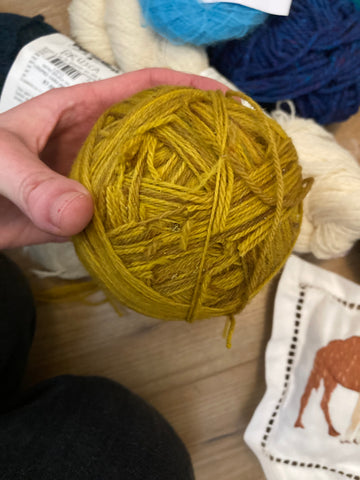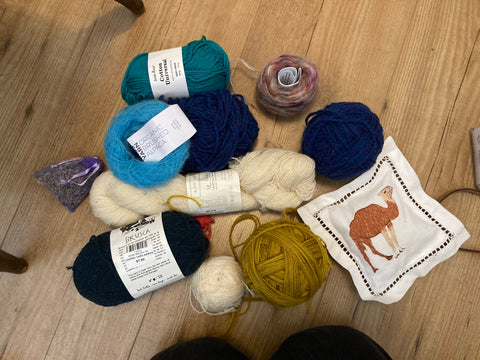Scary Knitting Stories: Moths! and how to avoid them
It’s October which means it’s time for all things spooky! While Vampires and Werewolves have their place this time of year, there’s something even scarier for us woolly wool lovers - moths. So what better time to share my own story of dealing with the ultimate creepy-crawlies? That’s right, this year I found moths in my home and lived to tell the tale. I’ll tell you the story as well as the tips I learned along the way.
Finding the Problem
The story starts off simple enough. One morning, I went into my stash to grab a skein for a project and was greeted with a hole in a ball of yarn full of eggs and one fluttering moth. I cried, I shrieked, I woke up my roommates. The shock was much more about the emotional significance than anything else: my collection is not just what I hope to knit with, it’s a memory chest. There were skeins I’ve had since middle school, gifts from dyers I’ve sample knit for, balls from yarn shops I worked in over the last few years. When I moved to Germany two years ago, one half of the biggest of my two suitcases was full of yarn. So needless to say, I was devastated.
You’ll know if your yarn has suffered a moth attack if there are breaks across multiple strands of yarn. If you find a snap in a skein at just one point, it’s likely a weak point from spinning or winding. However, moth larvae eat across a larger area meaning you’ll find many breaks along the way such as the photo below.

The Canary (Yellow Yarn) in the Coal Mine
Step One - Deal with the Problem
The first step (after crying) is assessing the damage and quarantine. I set aside any skein with signs of carnage and put the seemingly untouched ones in a large vacuum bag. Next I examined my zippered yarn container made out of waxed canvas, and realized that the construction allowed for gaps for bugs to get in. The bag and infected skeins had to go (tragic I know) but the silver lining is they’re made out of all natural woolly wool they can go in the compost and not a landfill. Be sure to check notions as things like lavender satchels or a leather pouch could also be part of the moth feast.

Almost Ten Skeins and several lavender satchels, which were also munched on
Save Your Skeins!
With the obvious damage out of the way, now it’s time to save your skeins! One option is to use heat, putting your skeins into the oven at least half an hour at a time at 120° F/50° C. This certainly will work with woolly wool but be careful of skeins with sparkly things in them like stellina. The other route, which I chose, is by freezing. I placed my sealed vacuum bag onto my balcony where the Berlin winter kept them at 15° F for a few days (at least 72 hours is recommended). I brought the bag inside to defrost, then put right back outside to freeze them again.
The next step came a week or so later when I bought a sealed, plastic container for storage.
Too scared to do it in my cramped apartment, my stash instead went on holiday with me to the middle of the woods where I did the next stop on our Airbnb porch. There every skein was inspected again for eggs, larvae, or the fluffy bits they create. All but two skeins passed this check. I then unwound every hank and shook it, hoping any remaining bits (or just dust) would go with the wind. This process is much easier with a beer in hand and a loving partner by your side.

Me inspecting my skeins outside in Schlannau, Germany
“Wing Cleaning” - Securing The Area
The most important thing to know with moths is that getting rid of them is more of a marathon than a sprint. This is to say, it’s a process. While my yarn was secured and obvious places were cleaned, over the course of the next months I noticed the occasional moth bobbing through the air so something was still wrong. I had already cleaned my apartment top to bottom, but I got the following cleaning supplies and did another round…
- Freshly cleaned Vacuum cleaner
- Mop with cleaning solution
- Vinegar-Water Mixture
- Lavender or Cedar Oil
- Someone to help move furniture to vacuum every surface
Put on your favorite tunes and get to work. I started by taking out all the clothes, washing them at a hot temperature, then wiping down all my shelves and surfaces with the vinegar mixture to help kill any eggs. Now’s also a good time to clean out any cracks where bugs may be lurking. I finished off my wardrobe with a rag and some cedar oil to shine up the wood and ward off more bugs.
The next step is moving everything around to find anything that may be a secret buffet for moths. When we moved my sofa, we found a wool sock and small J&S skein that had slipped underneath. They looked rough to say the least, so bad that I couldn’t bare taking a photo as evidence. But they were promptly thrown out and the area underneath vacuumed and mopped till it was squeaky clean. I’m actually preparing for a move to another neighborhood in Berlin, and the next step is putting our soft furniture in the garage and using a bug bomb to take out any stragglers that may have occurred. While I am not a fan of chemical solutions, this feels like the safest bet for making sure our new home remains moth-free.
Don’t Wait for Disaster to Strike
If you’re like me, your yarn stash and finished objects are much more than an accumulation of wool. They’re memories of the places traveled, people met, and many happy hours of learning about the sheep and other fiber animals who make our craft possible. My recommendation is don’t wait until you have a spooky story of your own, be proactive about moths as part of your routine cleaning. This includes…
- Putting up Pheromone Traps: Lavender and cedar do well at discouraging moths, but pheromone traps actually attract and trap them so you know if you’re dealing with a problem or not. They’re good for 3 months at a time, and I set a reminder on my phone for when it’s time to switch.
- Wash Your Knits Before Storage: Moths are attracted to food and human smells, so before your FOs go into storage for the season make sure to wash them with wool soap so that they are nice and clean before they hibernate for a season.
- Buyer Beware: Thrift stores and estate sales are great places to find yarn and other soft goods like clothes. Be sure to wash your items as soon as you bring them home, and you can even pop your yarn in the freezer for 72 hours to ensure you’re not bringing anything else home with you.
- Seal it Up: Store your yarn in a sealed container so that they’re not exposed to bugs and other elements like dust. My local Ikea had many options, but you can find options at many big stores like Target or WalMart.
The Woolly Thistle carries Cedar Packets, which are a proven moth deterrant. Toss one in to each of your yarn storage areas as an added measure!

So after finding and implementing these solutions, my place feels much more like home and less of a haunted house. I wanted to write this story not only as a spooky story for Halloween, but also to share information for how to deal with a problem many of us consider our worst nightmare. I’m curious to hear from you Thistlers - Have you dealt with moths? Do you have any tips on how to handle them? Here’s hoping your season is full of more (yarn) treats than (moth) tricks - Happy Halloween Thistlers!



























Are you supposed to remove the paper labels form the skeins before you place into the oven? Will they burn? Thanks.
I did a study of wool moths some years ago. The freeze for several days in a deep freezer and heat for several hours is the most effective method. A home refrigerator freezer does not get cold enough. The traps work well but cannot be placed too close together and will only catch some of the adults moths. Larvae are still there. Also moths seem to prefer cashmere and alpaca and the good stuff. The must like the fine fibers. They will also damage other natural fibers and have been known to take a bite out of synthetics. I am not sure if they are blends. They like to work in dark, undisturbed areas and seem to prefer baskets and backs of cupboards. Mothe may open a hole in thin plastic. I would suggest storage in freezer bags placed in a watertight plastic box. For knitwear always keep a bit of the leftover wool for possible future repairs or be creative and patch with visible mending. Vigilance rewards! I amsure clothes moths have an important role in decomposition but not with my stash please.
Thank you so much for this heartfelt, emotionally soothing and very informative exposé. You have calmed my nerves, even though I’m not even sure yet what I’m dealing with, but you’ve also very thoughtfully equipped me with the steps and the moral support to deal with it!
I always quarantine any yarn no matter the source. Use storage containers and zip lock type bags.
I too was infected a few years ago… devastating!
Putting the suspected infected yarn in a freezer does not kill moth larvae. Putting the yarn in the oven at 200 degrees for 20 min, being careful to not put in any yarn in the oven with metallic bits, will kill any moth larvae or other pests infecting wool ( like beetles and their larvae) I had a moth issue I struggled with for months and nothing helped until the yarn was put in a glass casserole dish into the oven.
Leave a comment